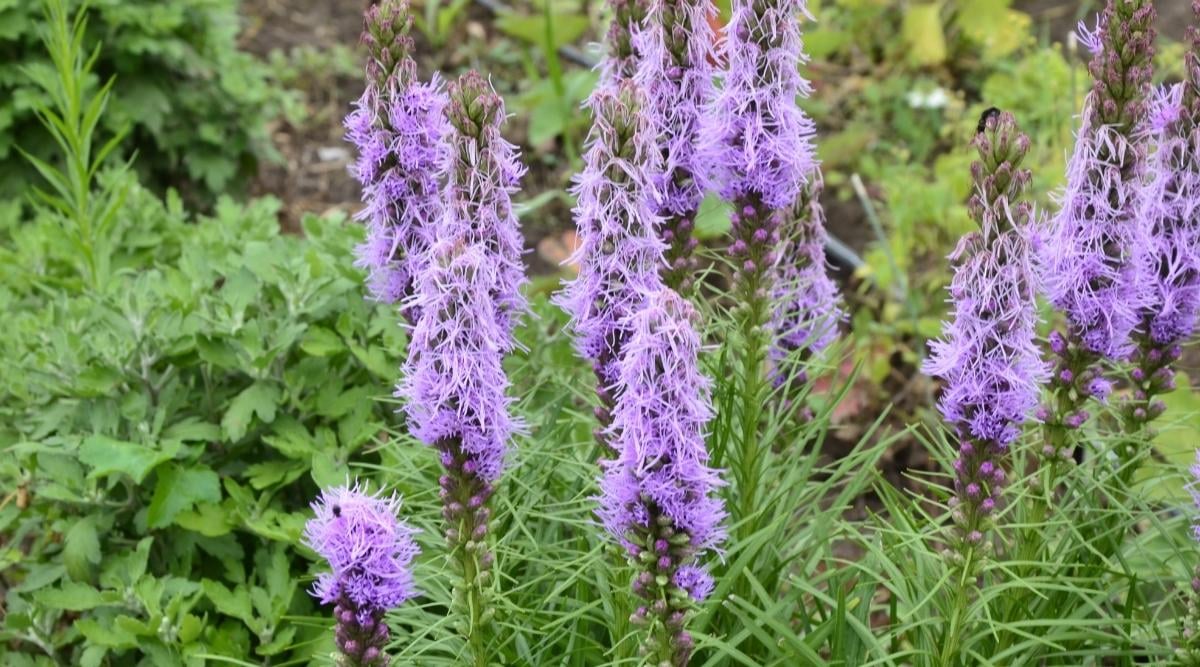jaundiceinnewborns.net – Gayfeather (Liatris spp.), also known as Blazing Star or Button Snakeroot, is a striking perennial flower that brings height, texture, and vibrant color to any garden. Native to North America, Gayfeather is prized for its tall, spiky flower heads, which are often adorned in hues of purple, pink, and white. With its unique flower structure and ability to attract pollinators, Gayfeather is a favorite among gardeners looking to add visual interest and support local wildlife. Here’s everything you need to know about growing and caring for this beautiful, hardy flower.
Appearance and Characteristics
Gayfeather is most commonly known for its tall, narrow spikes that are covered in small, feathery flowers. These flower spikes can grow anywhere from 2 to 4 feet tall, with some varieties reaching even higher. The individual flowers, which are typically clustered in dense spikes, have a unique shape, with each bloom resembling a small starburst. The flowers usually come in shades of purple or pink, though some white varieties are also available.
The plant’s long, linear green leaves grow in a basal rosette, adding texture and structure to the garden even when the plant isn’t in bloom. The flowers typically appear in late summer to early fall, providing a burst of color when many other flowers begin to fade.
Planting and Growing Conditions
Gayfeather thrives in full sun and well-drained, slightly sandy or loamy soil. It is a drought-tolerant plant once established and prefers areas with dry to medium moisture levels. These flowers are commonly found in prairies and meadows in their native habitats, and they do well in similar conditions in the garden.
When planting Gayfeather, it’s important to provide plenty of space, as the plants can grow quite tall and wide. Space plants about 12 to 18 inches apart to ensure good air circulation and to give each plant room to grow. Gayfeather is typically propagated from seeds or divisions. If growing from seed, sow them directly in the garden after the last frost, or start indoors in early spring.
Care and Maintenance
Gayfeather is a relatively low-maintenance plant, making it an excellent choice for gardeners looking for an easy-care flower. To encourage healthy growth, provide consistent watering during the plant’s early establishment phase, but avoid over-watering once the plant is established. Gayfeather is drought-tolerant and thrives with minimal water once it has developed a deep root system.
Fertilization is typically unnecessary for Gayfeather, as it grows well in poor to moderately fertile soil. However, applying a light mulch around the base of the plant can help retain moisture and keep the roots cool. Deadheading spent flowers is not required but can improve the plant’s appearance and extend the blooming season. In fall, once the flowers have faded, the plant can be cut back to the ground.
Pests and Problems
Gayfeather is generally resistant to most pests and diseases. However, like many plants, it can occasionally attract aphids or other small insects. These can typically be controlled with insecticidal soap or by encouraging beneficial insects like ladybugs, which feed on aphids.
One of the main issues Gayfeather might encounter is fungal diseases, especially if the plant is in overly moist conditions. To prevent these, ensure proper spacing between plants to allow for good air circulation and avoid overhead watering. The plant is also susceptible to root rot if the soil does not drain well, so it’s important to plant it in an area with excellent drainage.
Uses in Landscaping
Gayfeather is a versatile plant that can be used in many different landscaping styles. Its tall flower spikes make it an excellent addition to the back of garden borders or in prairie-style plantings, where it can add vertical interest and color. Gayfeather also works well in wildflower gardens, meadow plantings, and naturalized areas, where its unique form and ability to attract pollinators are appreciated.
Because Gayfeather is known for attracting butterflies, bees, and hummingbirds, it’s an ideal plant for creating a pollinator-friendly garden. Its late-season blooms make it a valuable addition to any garden, providing nectar for pollinators when other plants may be finished blooming.
In addition to its beauty in the garden, Gayfeather also makes an excellent cut flower. The spiky blooms can be harvested and used in fresh or dried floral arrangements, adding texture and a splash of color.
Conclusion
Gayfeather is a stunning and hardy perennial that adds height, texture, and vibrant color to gardens. Its unique flower spikes and ability to attract pollinators make it a valuable addition to any landscape. Whether used in cottage gardens, prairie plantings, or as a border plant, Gayfeather is sure to provide months of beauty and interest. With its minimal care requirements and striking appearance, this plant is a perfect choice for gardeners looking to add a touch of drama and color to their outdoor spaces.
